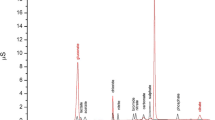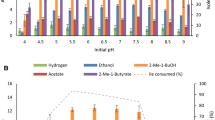Abstract
During the oxidation of various mixtures of glucose and aromatic substrates by four strains of Pseudomonas putida, diauxic growth was not observed. Strain A3.12 grew faster on benzoate than on glucose, whereas three other strains showed faster growth on glucose than on the aromatic test substrates. Growth rates on mixtures of glucose and aromatics were intermediate between those on the single substrates.
The presence of glucose in media containing aromatic substrates accelerated in the bacteria the appearance of the ability to oxidize aromatic substrates. During growth of the organisms on binary mixtures of aromatics, simultaneous utilization of these compounds occurred, the utilization ratio depending on the quality of the compounds as carbon and energy sources. Addition of glucose to dual aromatic substrate media greatly increased the utilization ratio in favour of the “better” aromatic substrate.
With decreasing concentration of glucose in relation to that of aromatic substrates, the rate of carbon assimilation from glucose increased. Enzymological and radiochemical studies demonstrated that even in the presence of an excess of aromatic substrates, glucose was exclusively catabolized via the 2-keto-3-deoxy-6-phosphogluconate pathway. In contrast, the rate of carbon assimilation from 14C-ring-labelled benzoate and anisate was unaffected by the presence of an excess of glucose.
Similar content being viewed by others
Abbreviations
- KDPG:
-
2-keto-3-deoxy-6-phosphogluconate
- PP:
-
pentose-phosphate
- OD:
-
optical density
References
Buswell JA, Mahmood A (1972) Bacterial degradation of p-methoxybenzoic acid. Arch Mikrobiol 84:275–286
Dagley S, Nicholson DE (1970) An introduction to metabolic pathways. Blackwell Scientific Publications, Oxford and Edinburgh
Karanth NGK, Reber H (1979) Regulation of the utilization of 4-hydroxybenzoate and 4-hydroxycinnamate in batch and continuous cultures of Pseudomonas testosteroni. Arch Microbiol 120:97–103
Kirkland JJ, Durham NN (1965a) Synthesis of protocatechuate oxygenase by Pseudomonas fluorescens in the presence of exogenous carbon sources. J Bacteriol 90:15–22
Kirkland JJ, Durham NN (1965b) Correlation of carbohydrate catabolism and synthesis of macromolecules during enzyme synthesis in Pseudomonas fluorescens. J Bacteriol 90:23–28
Kunc F, Kotyk A (1974) Effect of glucose on vanillic acid oxidation in Cellulomonas sp. Folia Microbiol 19:29–37
Lessie TG, Vander Wyk JC (1972) Multiple forms of Pseudomonas multivorans glucose-6-phosphate and 6-phosphogluconate dehydrogenases: differences in size, pyridine nucleotide specificity, and susceptibility to inhibition by adenosine 5′-triphosphate. J Bacteriol 110:1107–1117
Magasanik B (1962) Biosynthesis of purine and pyrimidine nucleotides. In: IC Gunsalus, RY Stanier (eds) The bacteria. A treatise on structure and function, vol 3: Biosynthesis. Academic Press, New York London, pp 295–334
Mandelstam J, Jacoby GA (1965) Induction and multi-sensitive end-product repression in the enzymic pathway degrading mandelate in Pseudomonas fluorescens. Biochem J 94:569–577
Pochon J, Tardieux P (1962) Techniques d'analyse en microbiologie du sol. Editions de la Tourelle, St. Mandé (Seine)
Reber H (1973) Comparative studies with two pseudomonads on the sequential degradation of aromatic substances metabolized via different pathways. Arch Mikrobiol 89:305–315
Reber HH (1980) Regulation of the utilization of 4-hydroxybenzoate and vanillate in batch and continuous cultures of Pseudomonas acidovorans. Arch Microbiol 126:65–70
Stanier RY, Palleroni NJ, Doudoroff M (1966) The aerobic pseudomonads: a taxonomic study. J Gen Microbiol 43:159–271
Umbarger E, Davis BD (1962) Pathways of amino acid biosynthesis. In: IC Gunsalus, RY Stanier (eds) The bacteria. A treatise on structure and function, vol 3: Biosynthesis. Academic Press, New York London, pp 167–251
Vincente M, Cánovas JL (1973) Glucolysis in Pseudomonas putida: physiological role of alternative routes from analysis of defective mutants. J Bacteriol 116:908–914
Wang CH, Stern I, Gilmour CM, Klungoyr S, Reed DJ, Bialy JJ, Christensen BE, Cheldelin VH (1958) Comparative study of glucose catabolism by the radiorespirometric method. J Bacteriol 76:207–216
Author information
Authors and Affiliations
Rights and permissions
About this article
Cite this article
Reber, H.H., Kaiser, P. Regulation of the utilization of glucose and aromatic substrates in four strains of Pseudomonas putida . Arch. Microbiol. 130, 243–247 (1981). https://doi.org/10.1007/BF00459527
Received:
Accepted:
Issue Date:
DOI: https://doi.org/10.1007/BF00459527




